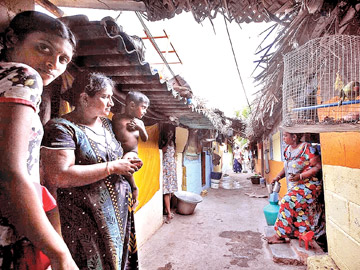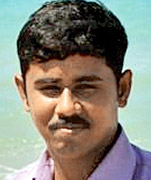|
Only 8,000 refugees have returned to Sri Lanka - Study
Thirty-year-old Mayuran is a Sri Lankan Tamil refugee who returned to his
hometown in Mullaithivu in April last year. Mayuran came to India in 1990, at
the age of four. He moved to Chennai in 2007 and earned a Masters’ degree and
then an MPhil from Loyola College.
 |
|
A refugee camp in Tamil
Nadu. Pic: Courtesy srilankabrief.org |
 |
|
Mayuran |
“As a refugee, I got a lot of opportunities and exposure, but I knew I didn’t
have a future in India,” he told The Times of India (TOI), over phone from
Mullaithivu.
Employed with the non-profit, Organisation for Eelam Refugees Rehabilitation (OfERR)
Ceylon as a programme officer now, he has also applied for a lecturer’s job at
the local university and also to universities abroad.
“Life in India has lifted me up. Had I been in Sri Lanka, I would have fought in
the war and died,” he says. Mayuran is one of the many returnees featured in a
new documentary film, titled ‘No Longer A Refugee’, produced by OfERR in
association with Ashok Gladston Xavier, head of the department of social work,
Loyola College, based on a study authored by him.
The study examines the challenges faced by Sri Lankan refugees who have returned
to their country and settled in areas such as Jaffna, Kilinochchi, Mannar,
Mullaithivu, Vavuniya, Batticaloa, Trincomalee and Kandy, especially in setting
up homes and finding jobs.
Of 65,000 refugees in 110 camps across the state, around 8,000 have returned to
Sri Lanka of their own accord since 2009. However, between 2012 and 2014 the
number of returnees steadily decreased. The drop in numbers, the study reveals,
was due to ‘lack of political conduciveness and a range of issues that did not
match up to the expectations of the refugees to return’.
Mayuran points out that the first three to six months is the most difficult
period for returnees, but the Sri Lankan government has been offering support.
“Once a returnee comes back to village, he has to register with the government
officer, who recommends them for grant of land and financial assistance for
building a house,” he said.
The study also notes that there have been ‘significant improvements in
infrastructure, reduction of military interference in public life, elections
have been held in the north and east and the scope of violent conflict has
reduced.’
In India, refugees receive a monthly dole, free housing, subsidised provisions,
access to welfare schemes, and were allowed to work.
When they return to Sri Lanka, some are unable to find suitable employment.
Gnaneshwari, 38, and her husband lived for many years in camps in In dia, before
returning to Sri Lanka.
She recalls that her husband, a fisherman, had not stepped into the ocean the
entire time they were in India. “He almost forgot his profession,” she says.
Many don’t have documents to prove that they are citizens of Sri Lanka. Some
don’t have property, relatives or a place to stay. Youth educated in India fear
they may not get recognition for their education, while others are worried about
recurrence of war and army presence in the north and the east.
The study notes that the procedure for graduates to obtain the equivalent
education certificates in Sri Lanka is time-consuming and involves considerable
travel and expenses.
- Times of India
|

